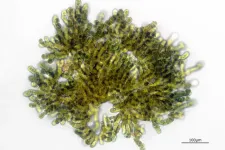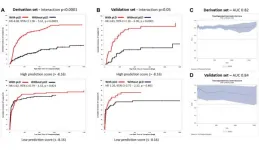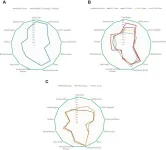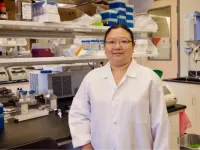Patients who quit smoking after percutaneous coronary intervention do as well as non-smokers – unless they had smoked heavily
2023-09-27
Patients who quit smoking after undergoing percutaneous coronary intervention (PCI) for narrowed arteries have similar outcomes as non-smokers during four years of follow-up after the procedure, according to a large study published in the European Heart Journal [1] today (Wednesday). However, if they had been heavy, long-term smokers, no improvement was seen.
The study of 74,471 patients who had a PCI between 2009 and 2016 is the first, large population-based study to examine the impact of smoking on cardiovascular outcomes, such as death, heart ...
USC launches liver disease study as part of $50.3 million “multi-omics” consortium
2023-09-27
The Keck School of Medicine of USC has received funding from the National Institutes of Health as part of a five-year, $50.3 million “multi-omics” study of human health and disease involving six sites. Researchers in the Multi-Omics for Health and Disease consortium will study fatty liver disease, hepatocellular carcinoma, asthma, chronic kidney disease, preeclampsia and other conditions, with a focus on underrepresented racial and ethnic groups.
Throughout the study, researchers will use ...
How silencing a gene-silencer could lead to new cancer drugs
2023-09-27
Deep inside our cells—each one complete with an identical set of genes—a molecular machine known as PRC2 plays a critical role in determining which cells become heart cells, versus brain or muscle or skin cells.
When the machine is missing or broken, normal fetal development can’t occur. If it’s mutated, cells can grow uncontrollably, and cancer can arise—a fact that has made PRC2 a source of keen interest for drug developers.
New research by scientists at CU Boulder and Harvard Medical School offers an unprecedented ...
A novel role discovered for vagus nerve
2023-09-27
The vagus nerve, known for its role in ‘resting and digesting’, has now been found to have an important role in exercise, helping the heart pump blood, which delivers oxygen around the body.
Currently, exercise science holds that the ‘fight or flight’ (sympathetic) nervous system is active during exercise, helping the heart beat harder, and the ‘rest and digest’ (parasympathetic) nervous system is lowered or inactive. However, University of Auckland physiology Associate Professor Rohit Ramchandra says that this current understanding is based on indirect estimates and a number of assumptions their new study has ...
THE LANCET: Gender inequalities worsen women’s access to cancer prevention, detection and care; experts call for transformative feminist approach
2023-09-27
Peer reviewed / Review, analysis and opinion
Cancer is a leading cause of mortality in women and ranks in the top three causes of premature death (under age 70) in women in almost every country worldwide.
New analysis finds, of the 2.3 million women who die prematurely from cancer each year, 1.5 million lives could be saved through the elimination of exposures to key risk factors or via early detection and diagnosis, while a further 800 000 deaths could be prevented if all women could access optimal ...
Prolonged mismatch between calories eaten and burned may be putting many athletes at risk of REDs (Relative Energy Deficiency in Sport)
2023-09-27
The estimated prevalence of REDs varies by sport, ranging from 15% to 80%. The syndrome often goes unrecognised by athletes themselves, their coaches, and team clinicians, and may unwittingly be exacerbated by the ‘sports culture,’ because of the perceived short term gains on performance from intentionally or unintentionally limiting calorie intake, warns the Statement.
REDs was first recognised as a distinct entity by the IOC in a 2014 consensus statement. This latest consensus, informed by a panel of international experts, draws on key advances in REDs science ...
Government policies work to reduce greenhouse gas emissions
2023-09-27
Policies designed to reduce greenhouse gas emissions have been effective, however more stringent regulations are needed to limit global warming to the Paris temperature goals, finds a new analysis by UCL researchers of international efforts to fight climate change.
The research, published in Annual Reviews of Environment and Resources, tracked the rate of greenhouse gas emissions over the last two decades against global efforts to reduce them. Since the early 2000s, governments around the world have enacted numerous regulations to curb greenhouse gas emissions. Over the same ...
Researchers combat Zika-associated fetal abnormalities using microRNA
2023-09-26
Before SARS-CoV-2 and the COVID-19 pandemic, there was the Zika virus epidemic, lasting from 2015 to 2016. The Zika virus can cause serious birth defects and abnormalities. During the epidemic, one of the most striking results of Zika virus in pregnant women was the increase in offspring with microcephaly or a head much smaller than expected, a condition that can result in abnormal brain development.
While the Zika virus epidemic has ended, future outbreaks are inevitable as most of the world’s population lives in areas where the Zika virus mosquito thrives. Researchers in the Aagaard Lab at Baylor College of Medicine ...
Double trouble: Infamous “eagle killer” bacterium produces not one, but two toxins
2023-09-26
The cyanobacterium Aetokthonos hydrillicola produces not just one, but two highly potent toxins. In the latest issue of the journal Proceedings of the National Academy of Sciences (PNAS), an international team led by Martin Luther University Halle-Wittenberg (MLU) and Freie Universität Berlin describes the second toxin, which had remained elusive until now. Even in low concentrations, it can destroy cells and is similar to substances currently used in cancer treatment. Two years ago, the same team established that the first toxin from the cyanobacterium is the cause of a mysterious disease among bald eagles in the USA.
Aetokthonos hydrillicola is ...
Study finds link to unclean cooking fuels and developmental delays in children
2023-09-26
BUFFALO, N.Y. – Just about everyone knows that cigarette smoke is bad for babies. Should cooking fuels like natural gas, propane and wood be viewed similarly when used indoors?
That’s the takeaway from a new study led by University at Buffalo researchers, who looked at indoor air pollution exposure and early childhood development in a sample of more than 4,000 mother-child pairs in the U.S.
“Exposure to unclean cooking fuel and passive smoke during pregnancy and in early life are associated with developmental delays in ...
Smart carts could detect fire hazards in nuclear facilities
2023-09-26
A University of Texas at Arlington researcher is working with a not-for-profit cooperative to develop and test a smart, automated cart that could replace humans who conduct fire hazard safety checks in nuclear power facilities.
Chan Kan, a UT Arlington assistant professor in the Department of Industrial, Manufacturing and Systems Engineering (IMSE), will lead the $250,000 project with the cooperative Utilities Service Alliance.
“We will develop and build a cart with state-of-the-art equipment that could replace human testing of nuclear facilities,” Kan said.
Currently, when the primary fire-sensing system fails or ...
Understanding of mechanisms behind post-exercise lack of appetite can open new paths to obesity treatment
2023-09-26
The complex relationship between physical activity and energy balance – food intake versus energy expenditure – is still a challenge for science, especially in light of the rising worldwide prevalence of overweight and obesity. Some of the medications available on the market to combat obesity work analogously to hormones associated with appetite control, and for some time researchers have focused on understanding how processes involving metabolites (products of cell metabolism) affect hunger and satiety.
A ...
Living donor liver transplant access is optimal for high-risk waitlisted cirrhosis patients
2023-09-26
“Access to LDLT in a transplant program can optimize the timing of transplant for the increasingly older, frail patient population [...]”
BUFFALO, NY- September 26, 2023 – A new research paper was published in Aging (listed by MEDLINE/PubMed as "Aging (Albany NY)" and "Aging-US" by Web of Science) Volume 15, Issue 17, entitled, “Availability of living donor optimizes timing of liver transplant in high-risk waitlisted cirrhosis patients.”
Liver transplant (LT) candidates have become older and frailer. Growing non-alcoholic steatohepatitis ...
ACC releases guide to home-based cardiac care
2023-09-26
The health care landscape has undergone rapid changes in recent years, requiring clinicians and stakeholders to consider innovative ways to provide care in traditional and non-traditional settings. The American College of Cardiology has released a workbook on home-based cardiac care that provides the cardiovascular care team with tools and resources to incorporate high-quality, patient-centered care in the home setting.
Home-based care is defined as any form of medical care that takes place in the home of the patient; this includes the acceleration of virtual ...
Transgenic T cells against malignant brain tumors
2023-09-26
Scientists from the German Cancer Research Center (DKFZ) and the University Medical Center Mannheim (UMM) successfully tested a new form of cellular immunotherapy against brain tumors in mice for the first time.
Glioblastomas are the most aggressive of all brain tumors. They spread diffusely in the brain and are difficult to remove completely by surgery. Chemotherapy or radiation therapy also often have limited effectiveness. To find new, more effective treatment options for those affected, doctors and scientists are testing numerous immunotherapeutic approaches, including so-called "adoptive" T-cell therapies: This involves isolationg ...
Aston University research pioneers making renewable hydrogen and propane fuel gases from glycerol
2023-09-26
Research shows way forward for making renewable hydrogen from glycerol
Crude glycerol from biodiesel production plants cheap and abundant
Could benefit the environment and reduce reliance on fuel imports.
26 September 2022 | Birmingham, UK
Aston University research has shown the way forward for making renewable hydrogen and propane fuel gases from glycerol.
An organic compound, glycerol is produced mainly from fats and oils and is often used in health and beauty products.
With crude glycerol from biodiesel production plants cheap and abundant the researchers have ...
SRI spins off AI-powered drug discovery platform Synfini, Inc.
2023-09-26
SRI International announced today it is spinning off Synfini, a biosciences platform that accelerates the process by which pharmaceutical and other companies can design, synthesize, and bring to market molecules for drug development.
The technology brings together a suite of software and hardware solutions developed at SRI through a significant, multi-year development effort. The suite includes a neuro-symbolic AI molecule designer, a computational synthetic planning tool, a high-throughput automated chemistry system, and a flow chemistry hardware platform that reliably performs multi-step synthesis.
“At SRI we are always tremendously excited to ...
Research reveals why our skin feels ‘tight’
2023-09-26
When we wash our face with a cleanser, our skin can start to feel tight. With the application of a favorite moisturizer, that feeling often goes away. This perception of our skin might seem subjective, but researchers at Stanford recently revealed the mechanism behind these feelings.
Their work, published this week in PNAS Nexus, demonstrates how mechanical changes at the outer surface of our skin translate into sensations and provides a quantitative approach for determining how people will perceive their skin after using a moisturizer or cleanser.
“This work provides ...
World-class neutron source takes a break for major Proton Power Upgrade
2023-09-26
The Spallation Neutron Source at Oak Ridge National Laboratory — already the world’s most powerful accelerator-based neutron source — will be on a planned hiatus through June 2024 as crews work to upgrade the facility.
Much of the work — part of the facility’s Proton Power Upgrade project — will involve building a connector between the accelerator and the planned Second Target Station at SNS. When complete, the PPU project will bring the accelerator up to 2.8 megawatts from its current record-breaking ...
Study sheds new light on strange lava worlds
2023-09-26
COLUMBUS, Ohio – Lava worlds, massive exoplanets home to sparkling skies and roiling volcanic seas called magma oceans, are distinctly unlike the planets in our solar system.
To date, nearly 50% of all rocky exoplanets yet discovered have been found capable of maintaining magma on their surfaces, likely because these planets are so close to their host stars they orbit in fewer than 10 days. Being so close causes the planet to be bombarded by harsh weather and forces surface temperatures to the extreme, making it all but completely inhospitable to life as we know it today.
Now, in a new study, scientists have ...
Latest version of the Healthy Eating Index covers toddler diet quality
2023-09-26
Philadelphia, September 26, 2023 – In four articles in the Journal of Nutrition and Dietetics, published by Elsevier, leading nutrition experts describe and evaluate the latest versions of the Healthy Eating Index (HEI), issued to correspond to the 2020-2025 Dietary Guidelines for Americans (DGA). For the first time, there are two new HEIs, one for children and adults 2 years and older, and one for young children aged 12 through 23 months.
The Call to Action of the ninth edition of the Dietary Guidelines for Americans is “Make Every Bite Count.” These guidelines form the basis of nutrition policy ...
U of M Medical School research team studies homicides of health professionals
2023-09-26
MINNEAPOLIS/ST. PAUL (09/26/2023) — Published in the Journal of Clinical Psychology, University of Minnesota Medical School researchers examined homicide rates of health professionals in the United States to inform prevention interventions and strategies.
The research team used the Centers for Disease Control and Prevention’s National Violent Death Reporting System (NVDRS) to collect data on the number of homicides among ten types of health professionals, including doctors, psychologists, nurses, social workers and pharmacists.
The study found rates of homicides ...
UH researcher on team developing sense-and-respond cancer implant technology
2023-09-26
The Advanced Research Projects Agency for Health (ARPA-H) has awarded $45 million to rapidly develop sense-and-respond implant technology that could slash U.S. cancer-related deaths by more than 50%.
The award to a team of researchers from seven states, led by Rice University, will fast-track development and testing of a first-of-its-kind approach to cancer treatment that aims to dramatically improve immunotherapy outcomes for patients with ovarian, pancreatic and other difficult-to-treat cancers.
Weiyi Peng, assistant professor ...
U of M Medical School receives $16 million to uncover the 'wiring diagram' of the brain
2023-09-26
MINNEAPOLIS/ST. PAUL (09/26/2023) — The University of Minnesota Medical School received a $16 million grant from the National Institutes of Health (NIH) Brain Research Through Advancing Innovative Neurotechnologies® (BRAIN) Initiative to support the groundbreaking project of unraveling the mysteries of the brain's ‘wiring diagram.’ Using cutting-edge techniques, this research aims to discover how the brain's neurons are connected and communicate with each other.
The project aims to better understand how complex neural ...
Arctic sea ice 6th lowest on record; Antarctic sees record low growth
2023-09-26
Arctic sea ice likely reached its annual minimum extent on Sept. 19, 2023, making it the sixth-lowest year in the satellite record, according to researchers at NASA and the National Snow and Ice Data Center (NSIDC). Meanwhile, Antarctic sea ice reached its lowest maximum extent on record on Sept. 10 at a time when the ice cover should have been growing at a much faster pace during the darkest and coldest months.
Scientists track the seasonal and annual fluctuations because sea ice shapes Earth’s polar ecosystems and plays a significant role in global climate. Researchers at NSIDC ...
[1] ... [1533]
[1534]
[1535]
[1536]
[1537]
[1538]
[1539]
[1540]
1541
[1542]
[1543]
[1544]
[1545]
[1546]
[1547]
[1548]
[1549]
... [8705]
Press-News.org - Free Press Release Distribution service.











